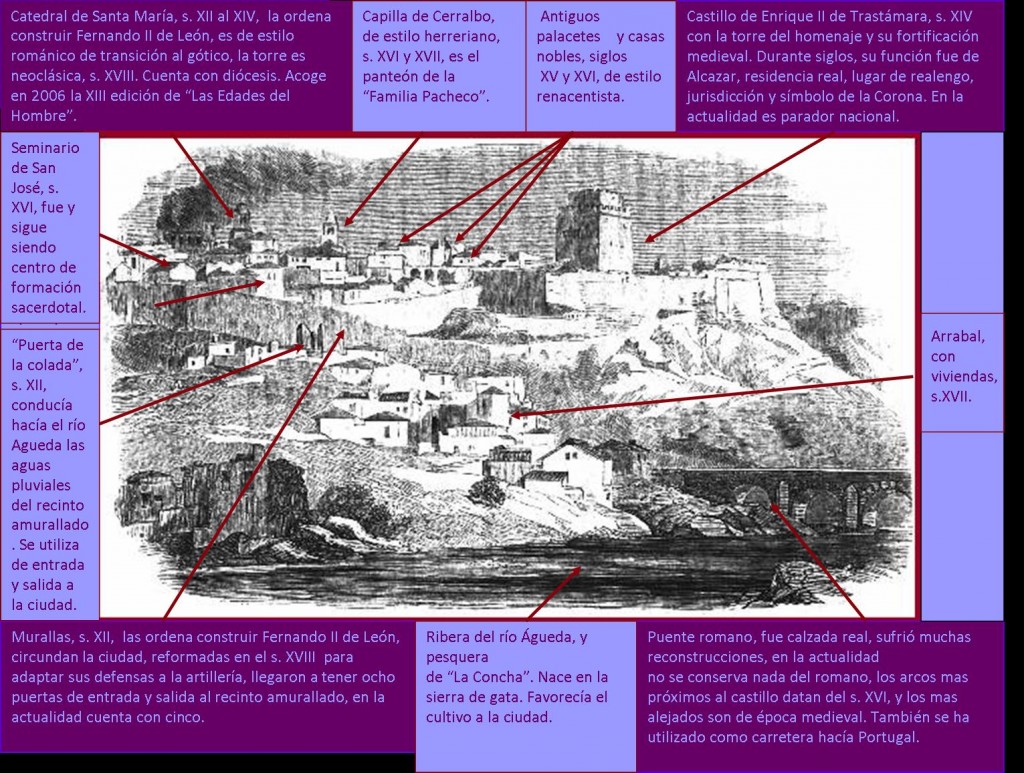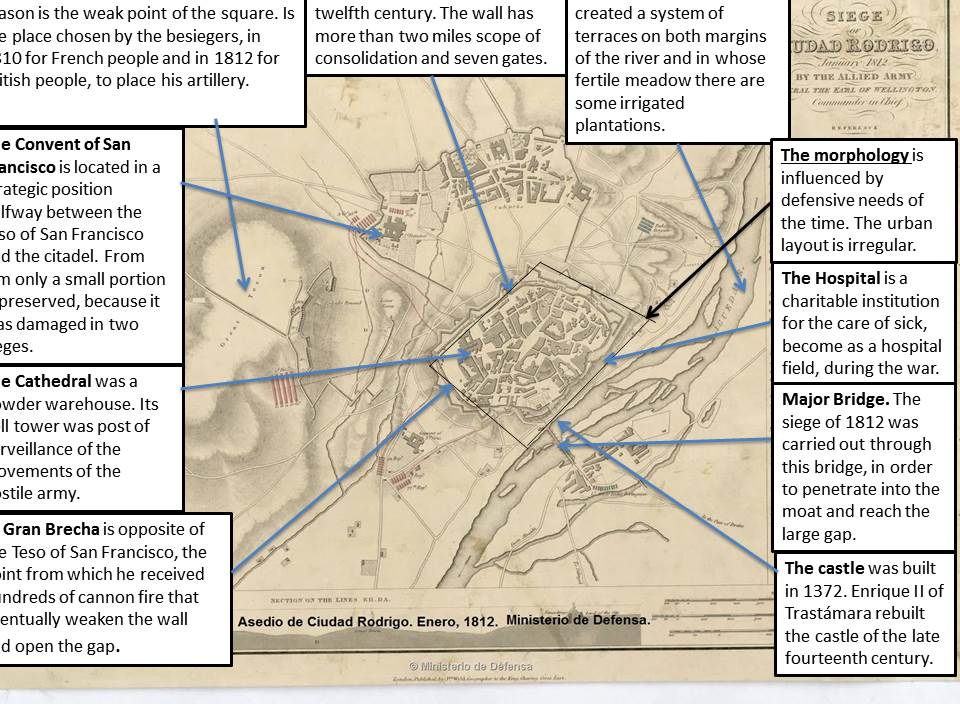CIUDAD RODRIGO (Joachim H. Stockler, 1812)
Este grabado pertenece al libro The life of the Field Marshall the Duke of Wellington, escrito por Joachim H. Stockler y publicado en 2010 por MSCS. Se titula “Ciudad Rodrigo, after siege. Jan., 1812 (Ciudad Rodrigo tras el asedio. Enero 1812). Se trata de una perspectiva de la ciudad desde la parte suroeste, en la que se muestra cómo era la ciudad durante la Guerra de la Independencia.
La configuración urbana está condicionada por su situación y emplazamiento. Ciudad Rodrigo se sitúa en una encrucijada de caminos, próxima a la frontera con Portugal, y se erige sobre un promontorio rodeado por el río Águeda. Como consecuencia de ello, el casco antiguo está circundado por fosos y murallas y su función es netamente defensiva. Morfológicamente es una fortificación en forma de estrella que rodea un trazado urbano irregular. El río Agueda ha creado un sistema de terrazas a ambos márgenes y en su fértil vega hay plantaciones de regadío, que también se extienden por los alrededores del término municipal, además de cultivos de secano, monte bajo y la dehesa salmantina con numerosas ganaderías. A las afueras de la muralla, en el arrabal, se construyeron viviendas en torno a los caminos principales que partían del núcleo de población sin un plan urbanístico previo.
En esta obra, el autor representa en primer plano el puente romano que cruza el río Agueda, junto a los arrabales, y en lo alto el esplendoroso castillo de Enrique II de Trastámara rodeado por su fortificado. Se aprecia también la muralla, que tiene mas de dos kilómetros de recorrido y que circunda a la ciudad en todo su perímetro. Además, se puede observar una de las ocho puertas de entrada y salida a la población, llamada “Puerta de la Colada”, que es la conduce hacía el río Agueda. En un segundo plano se aprecian algunos de los monumentos religiosos mas destacados de la ciudad, como la Catedral de Santa María, la Capilla de la familia Cerralbo, y el seminario de San José, así como varios palacios y casas solariegas, muchas de las cuales aun se conservan, dándole a la Ciudad un aire señorial.
Ciudad Rodrigo fue originalmente un castro vettón fortificado, que se denominó Miróbriga. A pesar de intentar repoblarla en tiempos de Alfonso VI, a cargo del Conde Don Rodrigo, de donde procede su nombre, no sería hasta 1161 cuando la población se asentó definitivamente, por orden de Fernando II de León. Este rey fue el gran benefactor de la ciudad, rodeándola de murallas, dotándola de silla episcopal, e iniciando la construcción de su magnifica catedral. Los siglos XV y XVI serían los de mayor esplendor, pues entonces se construyen numerosos monumentos religiosos, palacios y obras militares, como la fortaleza estrellada superpuesta a la primera muralla.
En los siglos XVII y XVIII, debido a la Guerra de Sucesión de Portugal y la Guerra de Sucesión Española, la mayor parte de la ciudad fue destruida. Lo mismo sucedió a principios del siglo XIX, con la invasión de las tropas francesas y la reconquista dirigida por el ejército angloespañol del Duque de Wellington. En 1944 la ciudad fue declarada Conjunto Histórico Artístico. Tras un proceso continuado de éxodo rural, desde 1976 comenzaron a regresar emigrantes desde Francia. Según datos del INE, Ciudad Rodrigo cuenta hoy con una población de 13.777 habitantes, de los cuales 6.677 son varones y 7.100 son mujeres.
Ana Belén Alcalde Expectación


